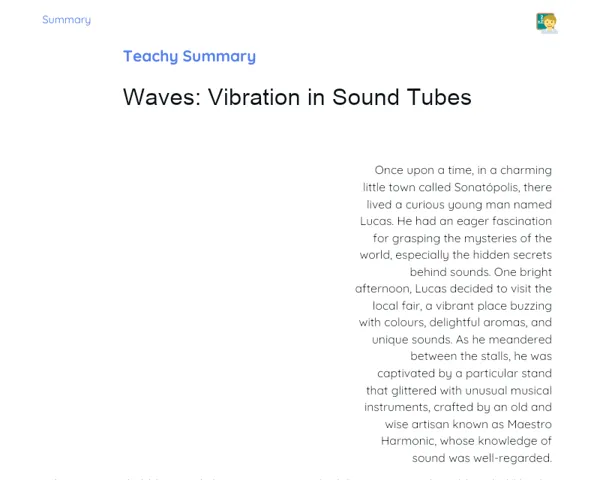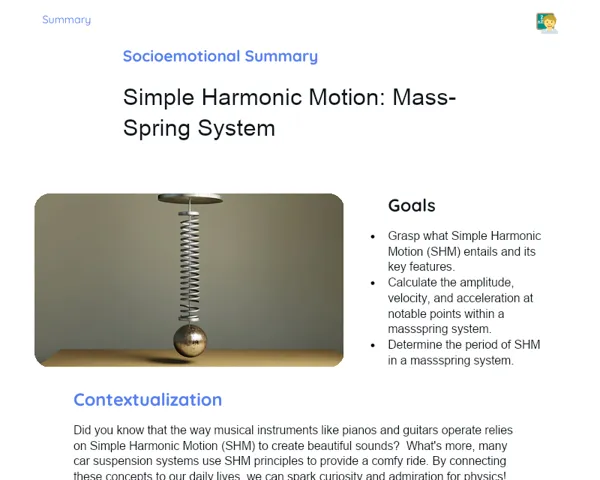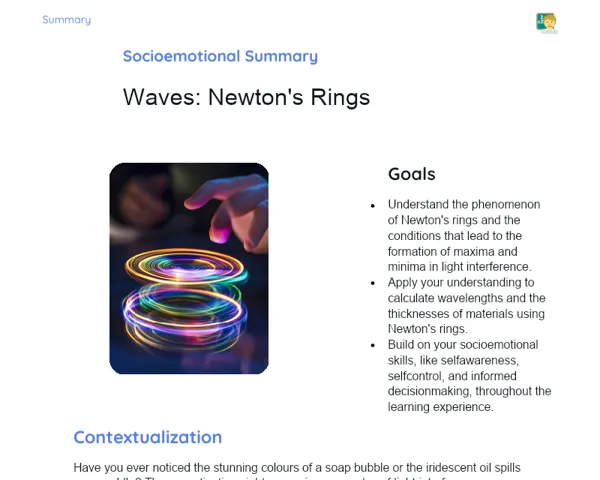Objectives
1. 📥 Understand and calculate how the apparent frequency of sound and light waves changes due to the Doppler Effect, especially when both the source and observer are in motion.
2. 📥 Explore how the Doppler Effect applies in everyday situations and its significance in astronomical phenomena like redshift and blueshift.
3. 📥 Develop both practical and theoretical skills through engaging activities and group discussions, aimed at ensuring a solid understanding of the topic.
Contextualization
Did you know the Doppler Effect is the same principle traffic radars use to determine the speed of a vehicle? This phenomenon isn't merely an interesting quirk of physics; it's an essential tool in numerous technological and scientific fields. In astronomy, for instance, it helps us understand the movement of stars and galaxies, giving scientists insights into how the universe is expanding and aiding in the discovery of planets in different solar systems.
Important Topics
Apparent Frequency
Apparent frequency refers to the frequency that an observer perceives based on the relative motion between the wave source (like sound or light) and the observer. This concept is vital to understanding the Doppler Effect, where the perceived frequency changes due to how the source and observer are moving in relation to each other. Grasping this idea is crucial for applying the Doppler Effect to real-world scenarios and simulations in the classroom.
-
As the source approaches the observer, the apparent frequency is higher than the actual frequency emitted by the source, because the sound or light waves are 'compressed,' reaching the observer at an increased frequency.
-
When the source moves away, the apparent frequency is lower because the waves are 'stretched,' leading to a perceived decrease in frequency.
-
It's essential for students to learn to calculate the apparent frequency using the Doppler Effect formula, as it not only deepens their theoretical understanding but also prepares them for real-world applications.
Blueshift and Redshift
Blueshift and Redshift are key concepts when studying waves affected by the Doppler Effect, particularly in astronomy. Blueshift occurs when an object, like a star, moves towards the observer, shifting spectral lines towards the blue end of the spectrum. Conversely, Redshift takes place when the object is moving away, which causes the spectral lines to shift towards red. These changes indicate astronomical movements and are critical for understanding the expansion of the universe.
-
Blueshift suggests that a star or galaxy is approaching us, hinting at movements within galaxy groups or binary star systems.
-
Redshift helps determine how fast objects like galaxies are receding from us, proving essential to our understanding of the universe's expansion.
-
By mastering these concepts, students can delve into and calculate complex astronomical phenomena, effectively applying mathematics and physics in a meaningful context.
Practical Applications of the Doppler Effect
The Doppler Effect has a myriad of practical applications that reach beyond theoretical study, impacting fields such as medicine, meteorology, and astronomy. For instance, in medicine, it is utilized in Doppler ultrasound exams to create images of the heart and blood vessels, aiding in blood flow evaluation and detection of possible abnormalities.
-
In meteorology, Doppler radar is crucial for forecasting weather system movements and detecting tornadoes, offering vital information for severe weather warnings.
-
In astronomy, the Doppler Effect is not just about measuring star and galaxy speeds; it's also employed in the search for exoplanets by analyzing speed variations caused by orbiting planets' gravitational pull.
-
Understanding these applications not only contextualizes the Doppler Effect study but also inspires students by showcasing how physics is applied in technologies that affect our daily lives and safety.
Key Terms
-
Apparent Frequency: The frequency perceived by an observer, which can differ from the actual frequency emitted by the source due to relative motion.
-
Doppler Effect: A phenomenon observed with waves when there is relative motion between the source and observer, resulting in a change in the perceived frequency.
-
Blueshift: A shift of spectral lines towards blue, indicating the object is moving closer to the observer.
-
Redshift: A shift of spectral lines towards red, indicating the object is moving away from the observer.
For Reflection
-
How can the Doppler Effect enhance safety in our everyday lives?
-
In what ways can understanding blueshift and redshift change our view on the universe's expansion?
-
What ethical considerations arise when using Doppler technology in sensitive areas such as healthcare and privacy?
Important Conclusions
-
The Doppler Effect is key to understanding how the frequencies of both sound and light change in situations where the source and observer are in relative motion.
-
We explored various practical applications of the Doppler Effect in fields like medicine with Doppler ultrasounds, and in astronomy, where it helps in measuring star and galaxy speeds.
-
Being knowledgeable about the Doppler Effect not only enriches scientific understanding but also paves the way for practical applications in technologies that influence our daily lives and well-being.
To Exercise Knowledge
Homemade Doppler Effect Simulation: Use a whistle or similar sound source and move quickly towards a friend, then away from them. Have your friend describe the changes in sound. Research on Doppler Effect Applications: Investigate how the Doppler Effect is used in weather forecasting or healthcare and prepare a concise report. Experiment with Lights: Use a torch and quickly move it towards a wall while observing changes in light intensity. Share your observations.
Challenge
🌌 Astronomical Challenge: Attempt to calculate a distant star's speed using made-up data about its observed redshift. Employ the Doppler Effect formula for light and share your findings and method with the class!
Study Tips
-
Create Flashcards: Make cards with key formulas and concepts of the Doppler Effect and practice regularly.
-
Educational Videos: Watch educational videos on the Doppler Effect to see practical demonstrations and explanations.
-
Group Discussions: Join a study group to talk through and solve problems regarding the Doppler Effect, which can help deepen your understanding and application of the concept.



